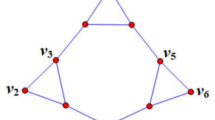Abstract
Graphs of separability at most k are defined as graphs in which every two non-adjacent vertices are separated by a set of at most k other vertices. For k ∈ {0,1}, the only connected graphs of separability at most k are complete graphs and block graphs, respectively. For k ≥ 3, graphs of separability at most k form a rich class of graphs containing all graphs of maximum degree k. Graphs of separability at most 2 generalize complete graphs, cycles and trees. We prove several characterizations of graphs of separability at most 2 and examine some of their consequences.
Access this chapter
Tax calculation will be finalised at checkout
Purchases are for personal use only
Preview
Unable to display preview. Download preview PDF.
Similar content being viewed by others
References
Arnborg, S., Proskurowski, A.: Linear time algorithms for NP-hard problems restricted to partial k-trees. Discrete Appl. Math. 23, 11–24 (1989)
Balas, E., Yu, C.S.: On graphs with polynomially solvable maximum-weight clique problem. Networks 19, 247–253 (1989)
Berge, C.: Färbung von Graphen, deren sämtliche bzw. deren ungerade Kreise starr sind. Wiss. Z. Martin-Luther-Univ. Halle-Wittenberg Math.-Natur. Reihe 10, 114 (1961)
Boliac, R., Lozin, V.: On the clique-width of graphs in hereditary classes. In: Bose, P., Morin, P. (eds.) ISAAC 2002. LNCS, vol. 2518, pp. 44–54. Springer, Heidelberg (2002)
Burlet, M., Fonlupt, J.: Polynomial algorithm to recognize a Meyniel graph. In: Berge, C., Chvátal, V. (eds.) Topics on Perfect Graphs. North-Holland Math. Stud., vol. 88, pp. 253–278. North-Holland, Amsterdam (1984)
Chudnovsky, M.: The structure of bull-free graphs I–III (submitted)
Chudnovsky, M., Robertson, N., Seymour, P., Thomas, R.: The strong perfect graph theorem. Ann. of Math. 164(2), 51–229 (2006)
Chudnovsky, M., Seymour, P.: Claw-free graphs. IV. Decomposition theorem. JCTB 98, 839–938 (2008)
Conforti, M., Cornuéjols, G.: Graphs without odd holes, parachutes or proper wheels: a generalization of Meyniel graphs and of line graphs of bipartite graphs. JCTB 87, 300–330 (2003)
Conforti, M., Cornuéjols, G., Kapoor, A., Vušković, K.: Even and odd holes in cap-free graphs. J. Graph Theory 30, 289–308 (1993)
Conforti, M., Cornuéjols, G., Kapoor, A., Vušković, K.: A Mickey-mouse decomposition theorem. In: Balas, E., Clausen, J. (eds.) IPCO 1995. LNCS, vol. 920, pp. 321–328. Springer, Heidelberg (1995)
Conforti, M., Cornuéjols, G., Kapoor, A., Vušković, K.: Even-hole-free graphs. I. Decomposition theorem. J. Graph Theory 39, 6–49 (2002)
Conforti, M., Cornuéjols, G., Kapoor, A., Vušković, K.: Universally signable graphs. Combinatorica 17, 67–77 (1997)
Conforti, M., Gerards, B., Kapoor, A.: A theorem of Truemper. Combinatorica 20, 15–26 (2000)
Corneil, D.G., Rotics, U.: On the relationship between clique-width and treewidth. SIAM J. Comput. 34, 825–847 (2005)
Courcelle, B.: The expression of graph properties and graph transformations in monadic second-order logic. In: Handbook of Graph Grammars and Computing by Graph Transformation, vol. 1, pp. 313–400. World Sci. Publishing, River Edge (1997)
Courcelle, B., Makowsky, J.A., Rotics, U.: Linear time solvable optimization problems on graphs of bounded clique-width. Theory Comput. Syst. 33, 125–150 (2000)
Diestel, R.: Graph Theory, 3rd edn. Springer, Heidelberg (2005)
Dirac, G.A.: On rigid circuit graphs. Abh. Math. Sem. Univ. Hamburg 25, 71–76 (1961)
Espelage, W., Gurski, F., Wanke, E.: How to solve NP-hard graph problems on clique-width bounded graphs in polynomial time. In: Brandstädt, A., Le, V.B. (eds.) WG 2001. LNCS, vol. 2204, pp. 117–128. Springer, Heidelberg (2001)
Gerber, M.U., Kobler, D.: Algorithms for vertex-partitioning problems on graphs with fixed clique-width. Theoret. Comput. Sci. 299, 719–734 (2003)
Gyárfás, A.: On Ramsey covering problems. Coll. Math. Soc. János Bolyai 10, 801–816 (1973)
Kloks, T., Müller, H., Vušković, K.: Even-hole-free graphs that do not contain diamonds: a structure theorem and its consequences. JCTB 99, 733–800 (2009)
Kobler, D., Rotics, U.: Edge dominating set and colorings on graphs with fixed clique-width. Discrete Applied Math. 126, 197–221 (2003)
Makowsky, J.A., Rotics, U.: On the clique-width of graphs with few P 4’s. International J. Foundations of Computer Science 10, 329–348 (1999)
Miller, G.L.: Isomorphism of graphs which are pairwise k-separable. Information and Control 56, 21–33 (1983)
Nagamochi, H., Ibaraki, T.: A linear-time algorithm for finding a sparse k-connected spanning subgraph of a k-connected graph. Algorithmica 7, 583–596 (1992)
Tarjan, R.E.: Decomposition by clique separators. Discrete Math. 55, 221–232 (1985)
Trotignon, N., Vušković, K.: A structure theorem for graphs with no cycle with a unique chord and its consequences. J. Graph Theory 63, 31–67 (2009)
Tsukiyama, S., Ide, M., Ariyoshi, H., Shirakawa, I.: A new algorithm for generating all the maximal independent sets. SIAM J. Comput. 6, 505–517 (1977)
Author information
Authors and Affiliations
Editor information
Editors and Affiliations
Rights and permissions
Copyright information
© 2011 Springer-Verlag Berlin Heidelberg
About this paper
Cite this paper
Cicalese, F., Milanič, M. (2011). Graphs of Separability at Most Two: Structural Characterizations and Their Consequences. In: Iliopoulos, C.S., Smyth, W.F. (eds) Combinatorial Algorithms. IWOCA 2010. Lecture Notes in Computer Science, vol 6460. Springer, Berlin, Heidelberg. https://doi.org/10.1007/978-3-642-19222-7_30
Download citation
DOI: https://doi.org/10.1007/978-3-642-19222-7_30
Publisher Name: Springer, Berlin, Heidelberg
Print ISBN: 978-3-642-19221-0
Online ISBN: 978-3-642-19222-7
eBook Packages: Computer ScienceComputer Science (R0)




